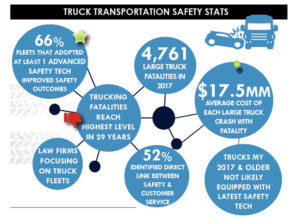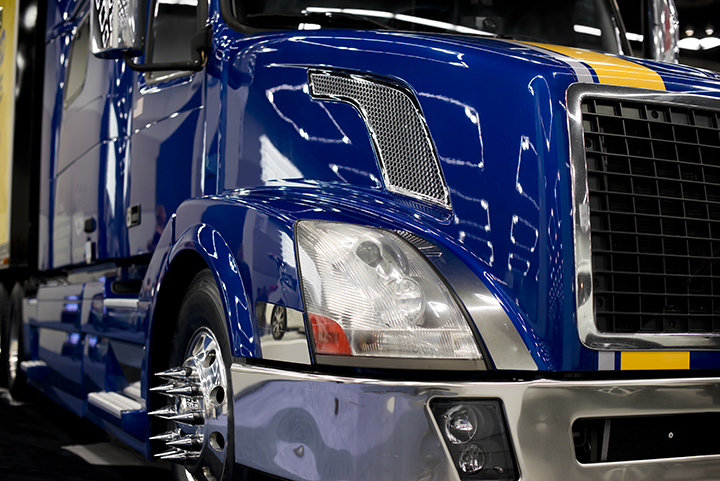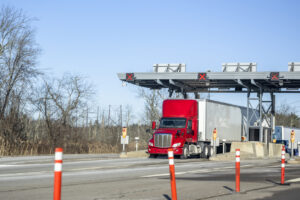FORT LAUDERDALE, Fla. — Fleet Advantage, a provider of truck fleet business analytics, equipment financing and lifecycle cost management, released results of its latest fleet industry benchmarking survey in late July. The survey shows the impact new safety technologies have had on transportation fleets, how many fleets are still driving older-model trucks, and the leading reasons motivating upgrade decisions. The survey also shows that demand for electric and autonomous trucks remains low.
Fleets with newer trucks benefit from more advanced safety features.

According to the benchmark survey, 71% of transportation fleets have implemented blind-spot mirrors as advanced safety features, while 66% have implemented front and rear disc brakes. The survey also showed that 11% of transportation fleets estimate they have saved more than $1 million in crash avoidance by upgrading to newer trucks that offer advanced safety features. These advanced safety technologies have led to safer roads for drivers, passengers and other motorists, and have lowered accident costs for carriers. This is especially important because trucking fatalities recently reached the highest level in the past 30 years, with the average cost of each heavy-duty truck crash reaching $17.5 million.
Additional statistics show that new safety technology aids in roadway safety, reduces accidents and improves Federal Motor Carrier Safety Administration (FMCSA) scores. Sixty-one percent of newer truck models offer forward-facing cameras, and 53% have lane-departure warning systems. While forward-facing cameras may not specifically prevent an accident from happening, the technology helps lower the overall costs involved in accidents and litigation. A University of Michigan Transportation Research Institute study found that car drivers were assigned contributing factors in 81% of crashes involving large trucks, versus only 27% for professional drivers. Forward-facing cameras help offer critical evidence that protects truck drivers in these instances.
Maintenance and repair are significant factors in deciding to replace older trucks.
The bottom line continues to drive many truck-upgrade decisions, and fleet executives are paying closer attention to the costs associated with servicing an aging vehicle. Fifty-five percent of fleets said escalating maintenance and repair costs (M&R) is a leading motivating factor for upgrading to newer trucks, and 47.3% of fleets said improved fuel economy was a leading factor. Other factors included driver retention and improved corporate image.
“There remains a distinct correlation between aging trucks resulting in higher service and repair costs, as well as reduced fuel economy,” said John Flynn, CEO of Fleet Advantage. “This survey tells us that many fleets see these as critical areas in not only operating their fleets, but also the impact they have on an organization’s bottom line.”
Full-service leasing remains an unpopular option.
Fleets continue to procure trucks in a variety of ways, including unbundled leasing or financing of new equipment as well as used vehicles, but only 8% of buyers are entering into a full-service lease agreement for their trucks.
Electric and autonomous trucks remain on the sidelines.
While there has recently been much discussion of electric and hydrogen fuel cell Class-8 trucks, 30% of respondents said they do not envision such vehicles being in wide use for another 10 years. (A year ago, 36% said they would not be widely used for another 10 years.) Another 62% pointed to the same time frame for autonomous trucks. In fact, only 3% of survey respondents believe autonomous trucks will be widely used by fleets within the next three years.
Companies need to replace older trucks in a financially responsible manner.
Despite all the advanced technology included in new trucks, the survey showed that roughly 50% of fleets utilize 2017 and older models, and some fleets have as many as 3,000 trucks older than 2017 models.
“These latest trends are an indication that more fleets are in need of innovative, flexible, and reliable programs that can help them replace their aging trucks with newer units,” Flynn said.
Click here to see the full infographic.
The Trucker News Staff produces engaging content for not only TheTrucker.com, but also The Trucker Newspaper, which has been serving the trucking industry for more than 30 years. With a focus on drivers, the Trucker News Staff aims to provide relevant, objective content pertaining to the trucking segment of the transportation industry. The Trucker News Staff is based in Little Rock, Arkansas.















